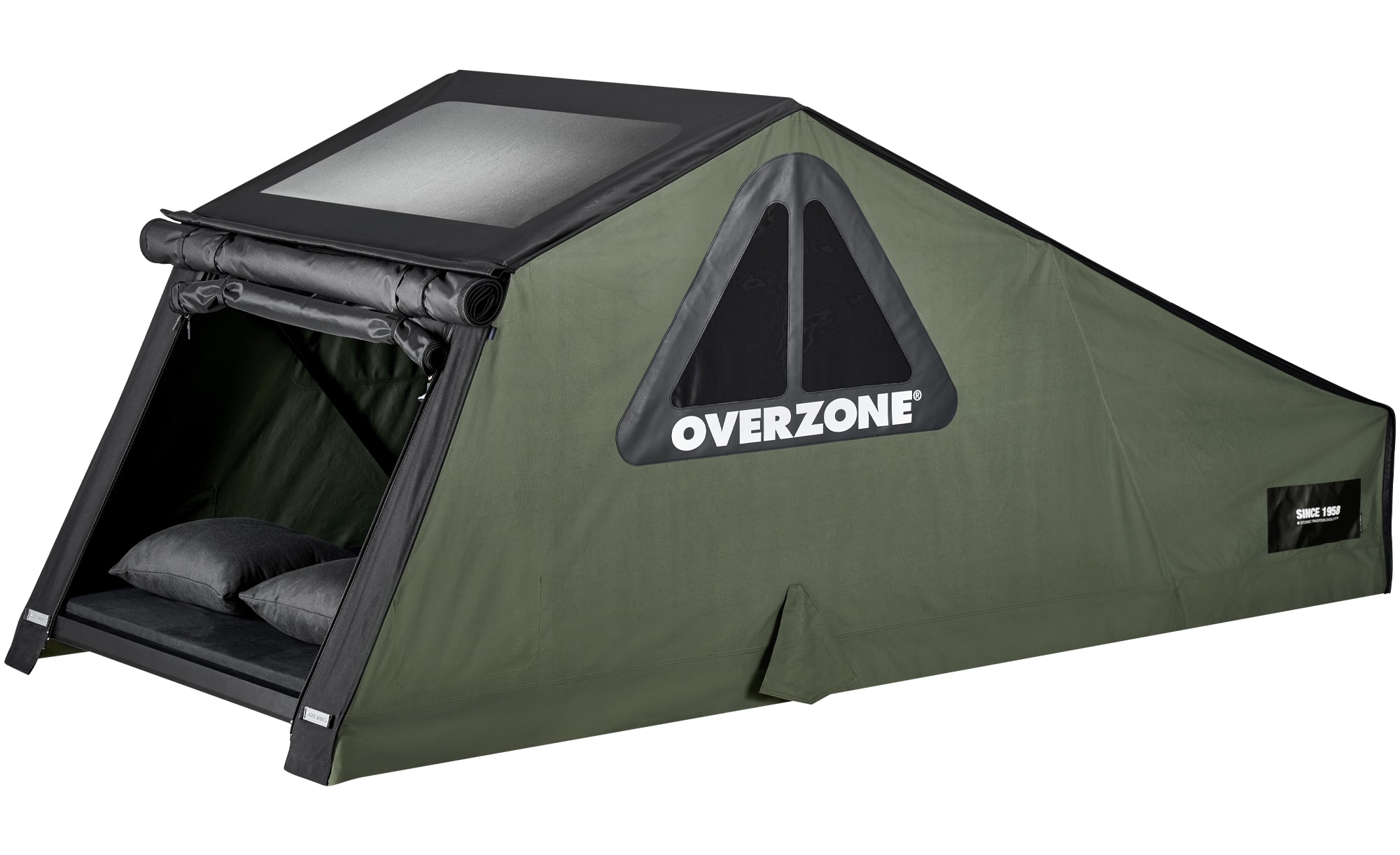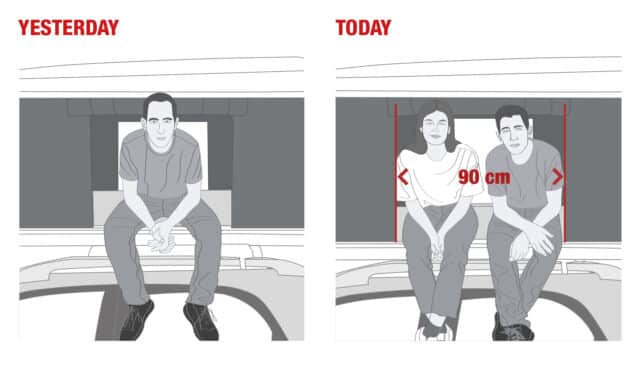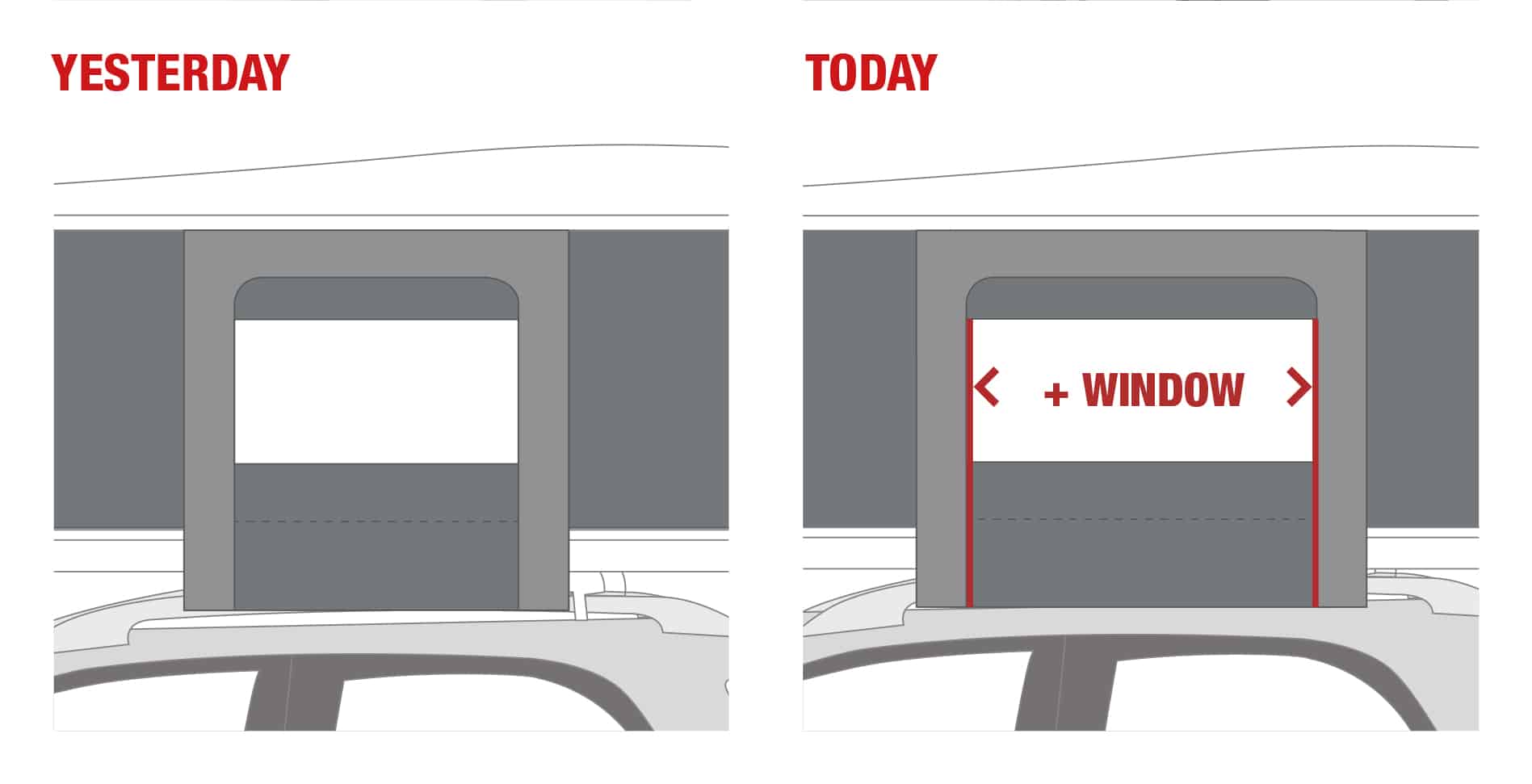TRAVEL FREEDOM
From the Rimini Off Road Show to the Tyrrhenean Sea passing over the Apennines. Travelling off-road with a tent on the roof
BY EUGENIO MARTIGNANI and VERA ROVERA
Crossing Italy from east to west in an off-road vehicle, we took Autohome roof tents with us. The Italian manufacturer, the world leader in its sector, has roof tents for every requirement. Essentially, there are two types: with hard shell or with strong waterproof cotton shell. Tents with two overlaid shells (the most famous is the Maggiolina) lift open and do not jut out. They open and close quickly and are perfect for trips with plenty of stops and starts. The cotton tents (the best-known is Air Camping) are more spacious and, opened, create a covered area next to the vehicle. They also leave part of the roof free for cans or a spare wheel. Each model is available with a variety of widths and for 2-4 people.
A trip with an off-road vehicle means total freedom, unfettered adventure. And what could be freer or more adventurous than an off-road trip with a roof tent, without the need to book a hotel? Even if a hotel actually existed on the kind of route you might choose, in the woods and mountains! Roof tents are increasingly popular because they are such a practical way of travelling. We took advantage of a raid by 4WD, organized with Autohome tents, to describe what it is like to sleep in a roof top tent, and to suggest what type of tent to look for, based on the materials and safety concerns. A group of off-road vehicles, all fitted with Autohome roof tents, left the Rimini Off Road Show, crossed the Apennines and reached the west coast and Tyrrhenean Sea three days later, after travelling on dirt roads and mule tracks, the same routes taken by our forefathers hundreds of years ago. The sea at Bellaria, north of Rimini, is calm when our convoy of off-road vehicles starts on its way, heading south-west. After a short time on the tarmac, we leave the civilized plain behind us and begin to throw up dust. The trip is long, including pebbly river beds at the bottom of the valleys, which we cross effortlessly and then begin to climb the rocky Apennines. Woods and meadows alternate, idyllic scenery, but the woodland lasts only for a short time because we are suddenly faced with a steep, deeply furrowed climb. The rule is to go up one at a time, first in the “trailblazer” then the less high-performance vehicles and the cars with road tyres. Last, the most expert drivers with profiled tyres. That evening we open the roof tents. No need for tent pegs, everything is ready in a matter of moments. We sleep above the ground, away from the moisture, in a genuine bed. In the morning, after a good night’s sleep, we are road to set off again. The hills become rolling, the view opens up and the woodland gives way to grassy meadows. The beauty of Tuscany and its white dirt roads! We reach Val d’Orcia and visit the village of San Quirico, with its Romanic churches and medieval walls, high up on a hillside along via Francigena. Here, it is also possible to visit the famous neighbouring towns of Montalcino and Pienza, but we have to stick to schedule. It is getting cold as we set up the second camp. Some have winter fabrics to keep them warm but even those who don’t, inside the well-insulated roof tent and sleeping bags, do not feel the cold. In the early morning, we follow a steep, furrowed canal with thick vegetation on both sides. The mule track then becomes a dirt road winding to the top of the hills and a dry torrent. It’s the third day of our journey and we can smell the Tyrrhenean Sea. We follow a dirt road through the woods and this is the most technically arduous part of the journey. We follow a pebbled river bed lined with massive stones and rock, which make it necessary to choose the precise route carefully and to use the accelerator sparingly. One by one we climb the banks and return to the dirt road and finally the tarmac. We are close to the sea and the end of our journey. On an overpass, we see the sea and head for the fortified coastline at Torre Mozza, not far from Piombino. Mission accomplished after a trip from the eat to the west coast of Italy, over the Apennines, following ancient dirt roads and paths. Three days immersed in nature, sleeping on the roof of our vehicles in comfortable tents. True travel freedom!
MADE TO MEASURE
Every model in the Autohome range of roof tents is available with dedicated accessories. In the Apennine trip the most useful proved to be the “winter-hood” (available both for hard shells and cotton tents) which covers the tent with a dual layer of waterproofing, insulating from the cold. Accessories include verandas and wings to protect the entrance of the Maggiolina from the sun and rain.
DETAILS THAT MATTER
Autohome tents are the result of over 60 years experience in manufacturing roof tents. Materials and finishes are of the highest quality to guarantee reliability and durability.
1. Tents with rigid shells clos without “pinching” the perimeter fabric.
2. The mattress is in high-density sponge for optimum overnight comfort. Shell roof tents are insulated and lit by a led.
3. All doors and windows are fitted with a mosquito net, which also keeps out small insects. They have strong zips.
4. Every model has its own hoisting and opening system, for rapidity and ease.
5. On the roof, the sides and inside the tent, elastic netting can be used to store clothes and documents.
6. Every model has a dedicated closing system with hooks guaranteeing maximum dynamic safety.
7. The anchoring brackets between the tent and roof rails run on a rail adapted for different distances. There are various sizes for different rails.
8. Each model has a telescopic ladder designed for the specific product.
GOOD TO KNOW
Autohome tents are designed to handle the toughest off-the-road conditions. However, you need to know how to set up the tent on the roof of a 4WD to make sure it is properly secured.
1. The two rails commonly used on road vehicles may not always be right. Three rails are often better, or a baggage holder with a number of anchoring points.
2. The rails should be placed solidly on the roof, preferably not near a side window but above, or close to, an upright.
3. Use only the anchoring brackets – between the tent and rail – manufactured by Autohome. These are specially designed and certified to German TUV standard.
4. Make sure the anchor bolts are tight – both between the rails and roof and between the rails and the tent – and check this from time to time during use.
A TENT FOR EVERY REQUIREMENT
Giovanni Barsotti is a quintessential sportsman. At a competitive and amateur level, he is a triathlete who has also competed in endurance and off-road 4WD racing. He has crossed the Lofoten Isles in Norway on foot and was a member of the 600 km “Italian Lapland Sled-dog” expedition in the Arctic Circle. He has organized and taken part in winter Arctic events such as a solo 850 km journey by snowmobile. In his 4WD he has driven across Northern Africa and taken part in trekking in Nepal at the foot of Mount Everest. Giovanni has a Columbus Small on the roof of his Toyota Land Cruiser: “The Maggiolina Columbus is a little smaller inside than cotton tents such as Air Camping, but is extremely stable, opens and closes quickly and is perfect for trips with plenty of overnight stays.” Veronica Capra and Francesco Basilico are a young, dynamic couple, with two lively children who don’t want to stay at home. They love the outdoor and sporting life, above all off the road. They have a Jeep, previously a CJ with Maggiolina tent on a makeshift structure, now a Grand Cherokee, chosen for its spaciousness. On the roof of the 4WD they have an Overland Large, able to cater for the entire family: “We chose Overland because of its internal space. It is comfortable for all four of us, and camping on the roof is great fun! The girls are so much in love with nature that even at home we have to set up the tent indoors so they can play.”
QUALITY AND CERTIFIED PERFORMANCE
Maggiolina and Air-Camping were created at almost the same time in Italy almost sixty years ago. The Autohome range (which now includes both the Maggiolina and Air-Camping) is sold the world over and is a synonym of quality. That’s why we guarantee every model for 5 years. Our quality certificates, after rigorous laboratory testing, are to ISO and DIN 75302/02.91 standards. The laboratory tests simulate extreme weather conditions and verify waterproofing, breathability and the Autohome fabric. The result is that the fabric enables the exchange of air preventing the formation of condensation, whilst being highly waterproof keeping the occupants of the tent perfectly dry. Autohome shell tents were tested in a climatic chamber to ECE/TRANS219 standards to verify how healthy the environment is inside. The inside temperature was raised from 8 to 31.5 degrees centigrade showing how the fabric managed to dissipate the heat. A second test, with a generator of water vapour switched on for 20 minutes inside the tent, showed that condensation is not formed due to the breathable fabric. Autohome tents also pass TÜV Rheinland tests for the anchoring system of the tent to the roof. Only safe, quality roof rails should be purchased.


















































